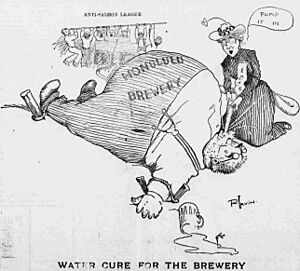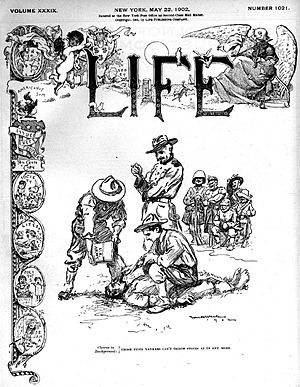Water cure (torture) facts for kids
The water cure is a harsh method of torture where a person is forced to drink a lot of water very quickly. This can cause their stomach to swell up, make them very sick from too much water, and in some cases, even lead to death.
This way of using water as torture has been recorded since at least the 1400s. The term "water cure" itself was first used in this painful sense around 1898 by American soldiers during the Spanish–American War. Before this, "water cure" usually meant a type of medical treatment using water. Today, a similar method called waterboarding exists, which focuses more on making someone feel like they are drowning.
Contents
History of Water Cure
Water cure has been used in many parts of the world throughout history. It was a common method of torture in different countries and during various conflicts.
Early Uses in Asia
The use of water torture by the Dutch in the East Indies (parts of Southeast Asia) was noted by English traders from the East India Company. This happened after a sad event called the Amboyna massacre in February 1623.
Water Cure in France
In France, water torture was used a lot and was even legal in courts from the Middle Ages up to the 17th and 18th centuries. It was known as "the question."
- The ordinary question involved forcing about 3.6 litres (one gallon) of water into a person's stomach.
- The extraordinary question involved forcing about 7.3 litres (two gallons).
Famous people who suffered this torture include the French poet François Villon in 1461 and Jean Calas in 1762. Stories about the Marquise of Brinvilliers also mention this method in books by authors like Arthur Conan Doyle and Alexandre Dumas, père.
Water Cure in Germany
During the Thirty Years' War, a form of water torture called the Swedish drink was used. Different armies used this method against the German people.
Water Cure in Spain
The Spanish Inquisition also used water cure as a form of torture. In 1620, a Scottish traveler named William Lithgow was subjected to it by the Inquisition in Málaga.
Water Cure in the United States
The water cure was present in the Philippines during Spanish rule. It was then passed on to Americans by Filipinos in 1899.
During the Philippine–American War
American soldiers used the water cure on Filipinos during the Philippine–American War. President Theodore Roosevelt once said it was "an old Filipino method of mild torture" and that "Nobody was seriously damaged." However, he also stated, "Nevertheless, torture is not a thing that we can tolerate." Reports from that time showed that it could indeed be deadly.
Water Cure by Police
In the early 1900s, some police in America used harsh methods to get people to confess to crimes. These methods were sometimes called "third-degree interrogation." Some of these techniques, like the water cure, were "covert" because they didn't leave clear physical marks. After a report in 1931 highlighted these issues, the use of such methods by police began to decrease.
Water Cure in Japan
During World War II, Japanese soldiers, especially the Kenpeitai (military police), used water cure in the areas they had taken over.
Water Cure in the Philippines
The water cure has a long history in the Philippines, used during Spanish, American, and Japanese rule. After the Philippines became independent in 1945, it was notably used by the government of former President Ferdinand Marcos.
The Marcos Regime
The water cure was one of the most common torture methods used during the Marcos regime from 1965 to 1986. Many groups, like the Task Force Detainees of the Philippines, documented these practices. Important survivors of this torture include Loretta Ann Rosales, who later became the head of the Philippines' Commission on Human Rights.
See also
- Waterboarding
- Water intoxication
- Water torture



